► Corvette ZO6 vs 911 GT3 RS
► Hardcore performance cars battle
► Chevy impresses, but can it topple Porsche?
For the first time ever, the hot version of the definitive US sports car seriously could beat the range-topping 911. Chevrolet’s new Corvette ZO6, complete with a flat-plane V8 and super-serious performance engineering is the closest any one car has come close to taking on Porsche’s ultimate 911. But will the Corvette topple it?
Pre-flight briefing: Chevrolet Corvette ZO6
Why is it here?
We’ve driven the new mid-engined Corvette before, but never in Z06 spec – a suffix synonymous with Corvette motorsport since 1963 and currently Corvette’s most potent C8. It’s not unusual for a mid-engined exotic to produce more power than a 911 GT3 RS, but the Corvette is unusual in costing substantially less than the 911’s £192,600; how much less will become clear when the Z06 goes on sale in the UK in the next few months.
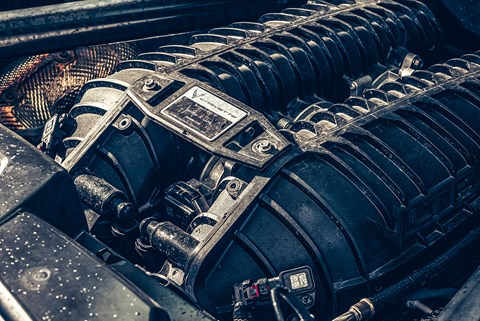
Any clever stuff?
The base Stingray uses a 6.2-litre LT2 V8, but the Z06 gets the clean-sheet 5.5-litre LT6 – with 661bhp it’s the most powerful naturally-aspirated production V8 ever. The hand-assembled unit also gets an aluminium block, forged aluminium pistons, forged titanium conrods, quad cams and a flatplane crankshaft that helps it spin to 8600rpm. Sad that Ferrari phased out the 458 engine? Meet your substitute.
Which version is this?
Our Z06 has a few desirable extras, notably the Z07 pack with carbonfibre aero package, FE7 suspension, carbon-ceramic brakes and optional carbonfibre wheels. It also has a ‘hardtop convertible’ roof that lifts out if you unclip three latches.
Pre-flight briefing: Porsche 911 GT3 RS
Why is it here?
It’s Porsche’s most hardcore model, and latest in an RS legacy dating back 50 years.
Any clever stuff?
The aerodynamics are something else. It starts with a single central radiator in the nose (rather than a 911’s normal three) that takes up the entire under-bonnet area, leaving space either side for active aero. A unique front wing design features air vents to release pressure above the front wheel and a brutal cutaway behind the front tyre that even necessitates a new CFRP door skin. A rear wing peaks higher than the GT3 RS’s roofline and features a DRS drag-reduction setting. Porsche claims peak downforce of 860kg. Other neat tricks include suspension compression and rebound settings as well as differential and traction/stability control parameters that you can adjust on the fly.
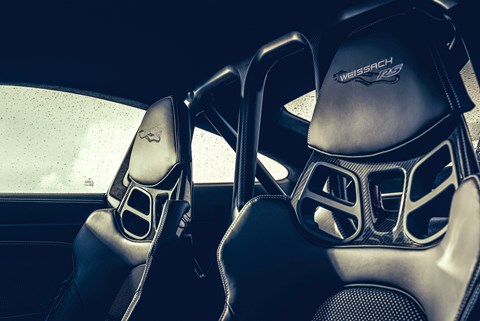
Which version is this?
This RS gets the £29,600 Weissach package, with the bonnet and roof in carbon weave (rather than CFRP), a half rollcage in CFRP rather than steel to save 6kg, and the anti-roll bars, rear coupling rods and rear shear panel all in CFRP too. Carbon-ceramic brakes (£7473) and a front-axle lift (£2546) are the other big-ticket items.
Read our Porsche 911 GT3 RS review
This is not a drill: Corvette ZO6 vs 911 GT3 RS
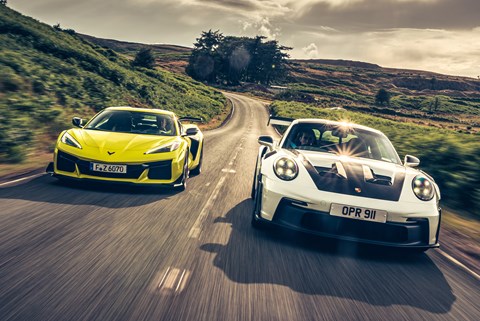
If the back story to the Porsche 911 GT3 RS tested here is unfamiliar, then I hope you’re enjoying your first issue of CAR magazine. But the Corvette Z06? Even most long-time (British) subscribers will have big gaps in their knowledge – previous generations were left-hand drive, after all.
The two have more in common than first impressions suggest. Both RS and Z06 were born from motorsport, celebrate big anniversaries in 2023 and are now more technically comparable than ever. Plus the new eighth-generation C8 Z06 is officially UK-bound in right-hand drive.
Prices are still to be confirmed, but the Z06’s $105,300 domestic retail price could easily balloon to around £140k for British buyers, though even that represents a big saving over a GT3 RS’s £192,600.
The Corvette might be from over the pond, but it’s no fish out of water. Threading over Welsh minor roads – crumbly cambered edges, encroaching bracken and sheep, more traffic than we hoped – the Z06 seems relatively compact and easy to place considering it isn’t that small, and quickly builds confidence with its (mostly) fluid steering and ride.
Limit handling is shot through with surprising finesse, but there’s bandwidth to ace long hauls too – CAR deputy editor Piers Ward just drove this left-hooker from Germany, noting: ‘Tour mode is surprisingly comfortable, with decent flex in the suspension to make a long stint bearable.’
Nicely placed pedals mean he hasn’t been twisting his right leg at awkward angles, and the two-seat cabin is so spacious I reckon you’d have to be over 6ft 5in tall to find it anything other than roomy – and that’s with a driver’s seat that could and should drop much lower. Generous luggage space and this convertible’s targa roof make it more versatile than the 911 too.
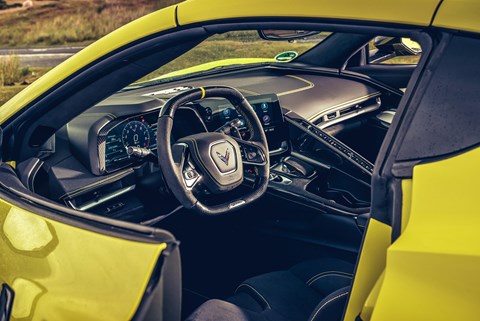
Now a model in its own right, the Z06 name dates to an option pack introduced 60 years ago for second-generation Corvettes. US car makers had an agreement at that time that factory teams wouldn’t race, so the Z06 gave privateers a kind of under-the-counter workaround that included stiffer springs, uprated brakes, a bigger fuel tank and a small-block V8 pushing out 360bhp.
RS was neither option pack nor racecar in a brown bag, but Porsche effectively worked the same magic when it took a 2.4S and cranked up the wick for motorsport, creating the 2.7 RS in ’73.
Our test cars continue those bloodlines, officially as the next best things to the Corvette C8.R and 911 RSR contesting the World Endurance Championship’s GTE class. (When more affordable GT3 machinery replaces GTE next season, the gap will be closer still.)
Just sitting inside reveals the C8 to be a very different Corvette – the bonnet plunges low between wheelarches cranked like spider legs, wide haunches with huge inlets for radiators fill the side mirrors, while a V8 engine lurks low in the rear-view.
All Corvettes are now based on a new all-aluminium, mid-engined architecture, but along with the Z06’s revised chassis, bigger brakes and shorter 5.56 final drive, there’s an all-new and far more sophisticated 5.5-litre LT6 engine too. Reasons to be cheerful include natural aspiration, sky-high 12.5:1 compression and – most significant of all – a flatplane crankshaft, like McLaren and Ferrari V8s.
A plaque says this one’s been hand-assembled by (spits out chewing tobacco, adjusts cap, leans in to double-check) Jennifer Cline in Bowling Green, Kentucky.
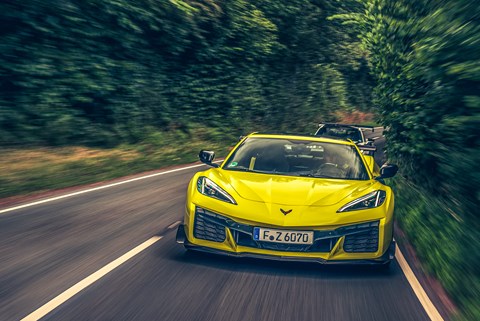
Fire it up and, oh… rather than the ripped muscle of the old supercharged pushrod LT4, a gruff resonance that you could mistake for a four-cylinder unit permeates the cabin and defines much of the Z06’s character at low to mid rpm.
Nor is this double overhead camshaft unit particularly muscular at a cruise – 460lb ft of torque is 190lb ft down on its predecessor, but it’s served way higher at 6300rpm compared to the previous 3600rpm. Pulling high gears at motorway speeds, it’s narcoleptic.
Patience, patience. That flatplane crankshaft conspires with heavily over-square cylinders to let the Z06 rip to 8600rpm, while 670bhp isn’t just 20bhp up on the previous Z06, it makes the LT6 the most potent naturally aspirated-production V8 ever.
The ’Vette doesn’t quite hang together when I first drive it. These roads run high through the Brecon Beacons and right now they’re slick with drizzle, plus our car’s got the (in other circumstances highly desirable) Z07 upgrade, which garnishes the ’Vette with suitably racy additions.
Every lip to a gravel car park threatens to destroy the Z07-specific carbon splitter (this car really needs the optional nose-lift) but Cup 2 R tyres are the bigger concern, with huge outer shoulders that have tread like a newborn piglet has hair. As well as the tyres and aerodynamic changes, the Z07 package also brings uprated suspension and carbon-ceramic Brembo rotors. Our test car also has carbonfibre wheels that save a huge 18.6kg of unsprung mass.
Perhaps I’m white-knuckling the wheel, but as I navigate blind turns and crests, the Z06 is a tad binary, sniffing around over the wet surface, demanding I bung in lock when instinct says go gentler. It doesn’t feel massively quick, the engine still isn’t singing in the meat of the midrange, DCT gearshifts are effective if a little bland…
At least the steering is punchy off-centre and combines fluidity, moderate weight and feedback to settle nerves, and the damping has a robust sort of compliance, supporting the body in compressions that’d karate chop the sumps from some cars. Shame there’s so much secondary patter on trickier surfaces -– it would be interesting to drive the same roads with the heavier stock rims.
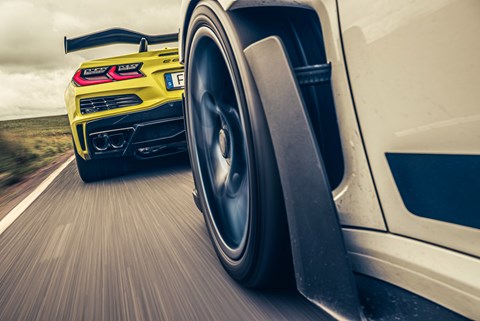
Tour, Sport and Track modes help fine-tune the dynamics, but you can pick ’n’ mix – brake pedal response and shocks mellowed off in Tour, a little extra steering heft in Sport and the V8 and dual-clutch ’box perked right up in Track does it for me. Stored in Z mode, it’s easily accessed on the oddly shaped if nice-to-grip steering wheel.
Finally the road fully dries and… oh my. At full chat the LT6 doesn’t have the parpy pomp of the Ferrari 458 that so clearly inspired it, but it wakes up at 4500rpm and the run from 6000rpm to the mid eights is a blur of speed, synaptic response and high-pitched histrionics that’s more scalded cat than old-school Corvette. Gearshifts simultaneously snap alive, quick on the upshifts, double-time on the way back down the ’box.
Because there’s a dearth of torque, a mid-mounted engine and compliant damping matched with near-slick road-legal tyres, you can just monster the (very looong travel) accelerator knowing the chassis has it covered, and you can beat the Porsche’s 3.2sec 0-62mph time. Even fully engaged traction control still gives me enough rope. My eyes don’t leave the road for a split-second.
Tramlining remains a minor distraction, but the more confident I am to hustle, the more casually I steer, the more it fades to the background. Plus you can roll so much speed into downhill corners I swear I’ll be ejected through a side window before these Cup 2 Rs let go – it feels wide, low, elbows out.
This is a beautifully balanced package with nicely rounded edges when you prod curiously at the limits, and mighty carbon-ceramic brakes with more friction than a Parisian banlieue. Jeez they’re noisy. But there’s little else to complain about. It’s very hard to imagine how the even hotter ZR1 version that’s expected as a 2025 model in the US will be better than this, at least as a road car. And before then, the Corvette range will be joined by a unprecedented newcomer, the all-wheel-drive hybrid E-Ray.
Lesser drawbacks of the Z06 include squeaks from the cockpit, combining in disharmony with the secondary wheel patter. The indicator stalks look and feel like cheap parts-bin afterthoughts, and they rather undo the classiness brought by the carbonfibre gearshift paddles. And, for me, the car’s overall looks don’t quite gel. I see Ferrari, I see Lamborghini, I see pleasing mid-engined proportions when I stand in the right place, but I also see the Looney Tunes drunk stork. The old front-engined Z06 looks way better IMHO.

Then again, while we’re criticising styling, who’d pick a 992 GT3 RS for its aesthetics? This feistiest of all 911s looks like it should be in parc fermé, not Powys, and I’m not the only one torn between self-consciousness and excitement ahead of my drive.
But with its wild wings and vents, a radiator filling what used to be a boot and even specially contoured double-wishbone front suspension, the RS generates a claimed 860kg of downforce at 178mph, double the last GT3 RS (and a ‘pah!’ to the Corvette’s 333kg at 186mph). Kilos might not have the pub kudos of bhp or mph, but aero is key to the GT3 RS’s performance.
Everything else is evolutionary versus the current GT3 – the 4.0-litre naturally-aspirated flat-six is bumped 15bhp to 518bhp thanks mostly to hotter cams, the final drive is shorter, and both stopping power (larger pistons, thicker discs) and chassis (29mm wider track at the front, stiffer rear springs) is uprated. Rotary controls on the steering wheel also let you independently fine-tune damper compression and rebound front to rear, while others tweak traction, stability and diff settings.
Glazed expression from man in pub… but fuse it all together with that aero, pop all the brave pills and the GT3 RS can lap the Nürburgring in 6min 49.328sec, scything 10.6 seconds from its GT3 sibling’s already rapid lap.
Our test car is more ’Ring-ready still, equipped with the – how much? – £29,600 Weissach pack that lavishes everything from roof to rollcage to anti-roll bars in carbonfibre.
My worry is just how much of this can be enjoyably tapped on the road versus a vanilla GT3, and if the seriousness of it all might actually detract from the drive.

And yet when I drop – and you do positively freefall – into the RS’s far more supportive sports seats, I exhale like I’m settling into a favourite chair. The driving position is perfect, the layout calmer and more logical than the Corvette, quality is on another level, the gorgeous alcantara steering wheel is actually round. The dry, sweet smell is immediately evocative of Stuttgart (someone says cannabis). I’d know where I was blindfolded.
I can even see out of the rear window, if only because the spoiler is actually higher than the roof, like I’m Richard Petty and this here’s a Plymouth Road Runner from NASCAR. Purposeful, then, but I don’t actually feel like I’m strapped in some brutalist racecar.
Smaller, narrower and torsionally stiffer (at least in feel) than the Z06, there’s consistency to everything the 911 does. Weights flow beautifully through its controls, whether that’s the take-up in the brake or throttle pedals, or how progressively forces build as you crank the ultra-precise steering. The RS seems to not so much turn as bend itself through slow- to mid-speed corners – the rear-wheel steering is more aggressive than a regular GT3’s.
Power and torque are both down versus the Corvette (518bhp and 343lb ft plays 661bhp/460lb ft) and delivered near identically on paper with best-’til-last 8500rpm peak power and tippy-toes 6300rpm peak torque. Thing is, the Porsche is way lighter with its 1450kg DIN weight (some 111kg fleeter than the dry weight Corvette quotes), and much peppier in normal driving.
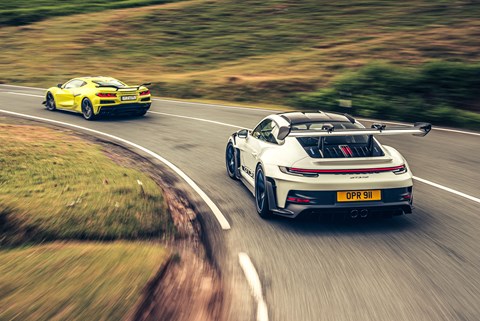
This is also the more characterful engine. The six might idle with grumbly industrial chatter, but as soon as you’re moving it’s smooth, bassy, flexible… lovely. Start working to 5000rpm-plus and you get a flavour of what’s to come – more treble, waspish intensity, performance zooming into focus. PDK gearshifts step up too, their easy finesse complemented by extra mechanical urgency (though I dislike the effort required to click the Weissach pack’s magnesium shift paddles).
All this makes the most hardcore of 911s approachable and engaging when I’m just stroking over this incredible landscape – astonishing given the RS is all about clawing extra tenths out of an already highly effective package.
Suspension compliance is key. Default modes are probably harder-edged than a GT3, but while I’m getting a bit lost in the rotary dials to adjust stiffness, CAR’s James Dennison shares a cheat – knocking everything back to full soft makes the RS more compliant than a regular GT3, and certainly the last 991.2 GT3 RS.
It works a treat. There’s one section of road with a run of washboard bumps that’d kick some hard-charging track cars into the valley below. The Corvette deals with them deftly enough, but even as I brace for the worst, the GT3 RS takes the hits like a punchbag – elastic, controlled, instantly ready for another upper-cut to the chassis. Plus it tracks calmer than the Z06, flowing deftly over this surface.
I don’t think I’m getting much benefit out of the RS’s wider front axle at these speeds given a regular GT3 is already so bitey, but there’s surplus grip whichever end of this car you push.
Climbing up through a quick S-bend on a deserted mountainside, the revs are lit and the flat-six wavers tremulously as 335-section rear tyres chew at the surface, suspension working hard to keep everything in check. It’s like I’m constantly fizzing up a bottle of champagne on the podium, every gearshift a pop of the cork.
The engine might be out-punched by literally all supercars and not feel particularly hungrier than a regular GT3, but the linearity of delivery, the precision throttle control, the way it’s hung over the rear axle, it’s all just so, and then the chassis and brakes (optional carbon-ceramics here) let you smash that performance like you’re knocking every ball for six.
Yet because the aero is doing very little at typical B-road speeds, it’s still malleable enough to be steered on the throttle, not some one-dimensional grip monster that wants to spit you off the road the second it lets go.
For a car that’s so biased towards extreme performance, the 911 GT3 RS is a surprisingly complete machine. No wonder we all make a play for the keys whenever we can. But that’s to take nothing away from the Corvette – the car from Kentucky can disappear into the sunset with its head held high.
Final reckoning: Corvette ZO6 vs 911 GT3 RS
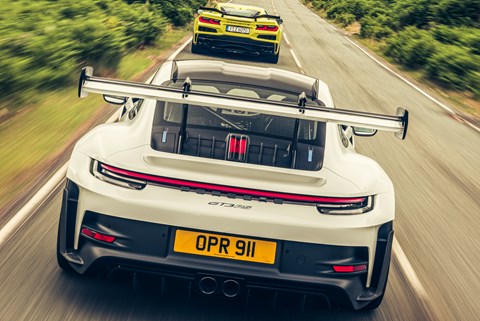
For decades the Corvette has been an over-powered niche prospect for UK buyers, but the C8 Z06 is far more European in concept and feel. Not only can Brits specify a steering wheel on the correct side, but the mid-engined layout and flatplane V8 put the accent on satisfyingly nuanced handling and the high-rpm power delivery that’s so perfectly suited to making the most of that chassis.
Born in Kentucky it might be, but the Z06 feels at home on UK roads, with its well resolved damping, handling that’s as nimble as it is exploitable, and searing naturally aspirated power delivery clearly inspired by Italy’s best. Even if we would like more pep and connection at normal speeds and a little less tramlining on British B-roads, the Z06 is a highly satisfying steer.
If anything’s likely to be lost in translation, it’s the Z06’s price. It retails for less than half the cost of a 911 GT3 RS in the US, making it a seriously affordable alternative not only to that car, but to a GT3 too.
But a UK Z06 is likely to land bang in GT3 territory. That’s a big ask when the – albeit much improved – interior quality and infotainment still lag behind its German rival, and the powertrain can’t sing quite like a GT 911 can.
We’d do nothing to discourage those keen to take the plunge, but the 911 GT3 RS does remain the superior car by a margin. All our testers praised the precision of the RS’s steering, its effervescent flat-six and PDK powertrain and handling that’s as resolutely grippy as it is finger-tippy tactile.
The RS is also a surprisingly compliant machine, sophisticated enough to flow over tricky terrain, never so responsive as to be nervous – in fact better in this respect than the last GT3 we tested.
Individually adjusting bump and rebound, tweaking e-diff settings and tailoring the stability and traction control might be overkill for some drivers, but it adds depth to the GT3 RS experience, letting owners quickly experiment and feel the difference in a way that’s usually impossible without a lot of faffing about. Not bothered? Use the defaults.
Personally I’d take a GT3 Touring manual as a road car – more affordable, less ostentatious, an actual boot – but the GT3 RS is far from the compromised trackday weapon first impressions suggest.
In fact, while it might have already recalibrated our perception of what a road-legal 911 can achieve on a racetrack, the real revelation here is just how much of that magic translates to the road.
Top honours for the 911, then, but high acclaim for a Corvette that now boasts the sophistication to take it on.
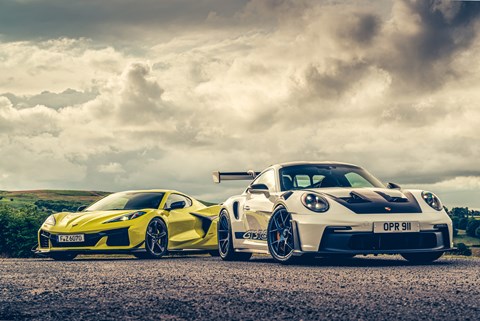
Verdict: Corvette ZO6 vs 911 GT3 RS
First place
Porsche 911 GT3 RS
Absolutely brilliant execution. Just be sure this is the 911 you really want
Second place
Chevrolet Corvette Z06
The Z06 at no point feels like it’s been put in the wrong test. But it never feels like a better car than the RS